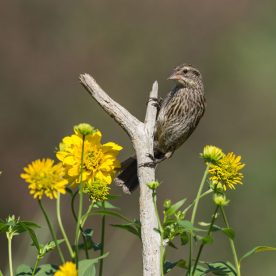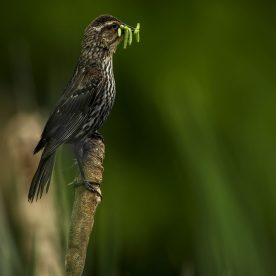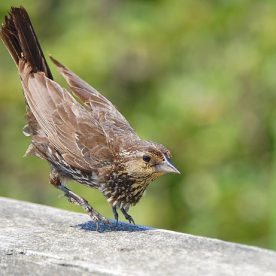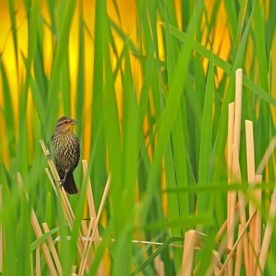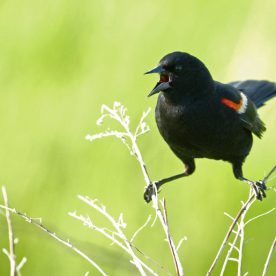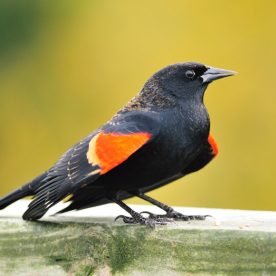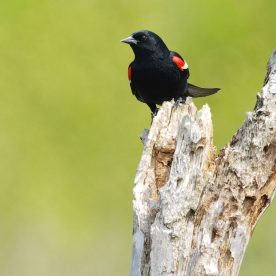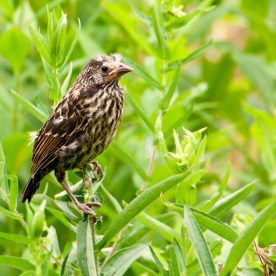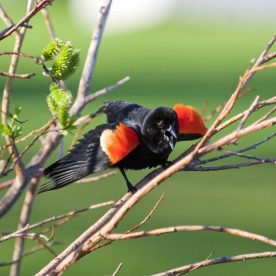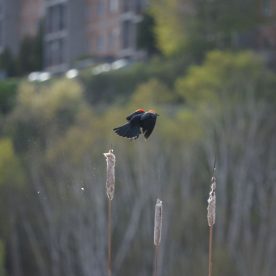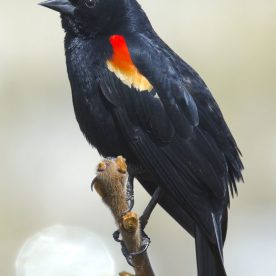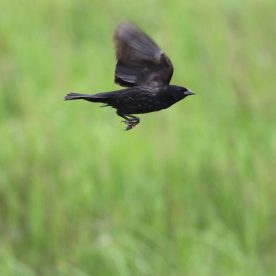Description
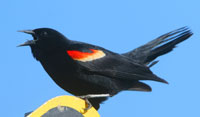
Male red-winged blackbirds are black with distinctive red epaulets on their shoulders. Sometimes the red is concealed with only a yellow margin showing. Immature males also have red shoulder patches but can be sooty-brown and appear mottled.
Red-winged blackbirds are medium-sized song birds with a length of approximately 17 to 23 centimetres and weigh 32 to 77 grams. Females are somewhat smaller than males.
Females, very different in appearance from adult males, are brownish and have streaked breasts. Females are often mistaken for other blackbirds or large sparrows.
Signs and Sounds
Red-winged blackbird calls sound like loud check and a high slurred tee-err sound when alarmed. Their song is a liquid gurgling konk-ke-ree…
Habitat and Habits
Red-winged blackbird habitat includes a variety of wetlands including marshes (freshwater and brackish) and swamps. They are also known to inhabit uplands like hayfields, croplands, meadows and oil fields and sometimes wooded areas along waterways and open patches in woodlands.
These well-known birds are one of the first signs of spring in Canada. Their spring migration takes place from mid-February through mid-May. Their fall southern migration begins as early as August. The male red-winged blackbird returns before the female in the spring and leaves after the female in the fall. They migrate in large flocks and travel during the day.
Red-winged blackbirds also feed and roost in large flocks.
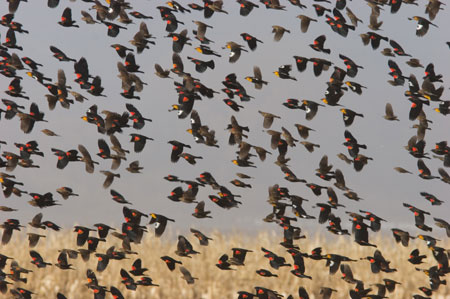
Unique characteristics
- The red-winged blackbird is best known for the males’ distinctive red shoulder patches called epaulettes.
- It is believed to be one of the most numerous land birds in North America
- The male will aggressively defend its territory during breeding season against intruders.
- They also have the ability to hop backwards while foraging which is referred to as “double scratch”.
Range
Red-winged blackbirds range from northwestern British Columbia and Alaska to southwestern Newfoundland and south to Costa Rica, the northern Bahamas and Cuba.
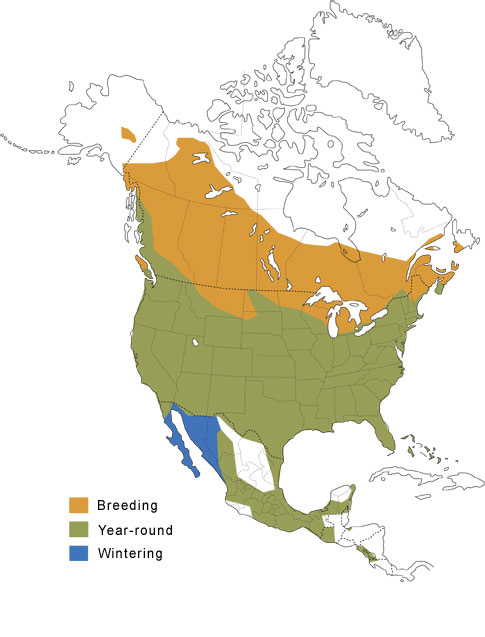
Red-winged blackbirds breed in wetlands across Canada as far north as southern Yukon; northern Saskatchewan; central Manitoba; north-central Ontario; southern Quebec; and south western Newfoundland and Labrador.
They winter in southern British Columbia , extreme southern Ontario, Nova Scotia and rarely in southern Quebec.
Feeding
Red-winged blackbirds eat mostly seeds, grains, berries and wild fruit and in summer will also eat insects, caterpillars, grubs, spiders, mollusks and snails. They are able to walk, run or hop while foraging on the ground.
Breeding
The red-winged blackbird is a polygynous species, meaning the male mates with more than one female in a single breeding season. In fact, one male can have as many as 15 different females nesting in his territory
Red-winged blackbirds can have two to three broods per year. Their nests are woven cups made of marsh vegetation lined with fine grasses fastened to reeds, deep grass and bush. They lay three to five, usually four, bluish-green spotted eggs that the females incubates for approximately 11 to 13 days.
Red-winged blackbird young stay in the nest for 9 to12 days. Young red-winged blackbirds that may fall from their nests have a limited ability to swim short distances. Adults do not swim.
Conservation
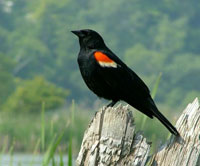
Red-winged blackbirds are abundant in North America and also widely studied.
The main threat to red-winged blackbirds is habitat loss due to drainage of wetlands for development and agriculture.
As with many other birds, red-winged blackbirds are vulnerable to pesticides in the food chain.
The main predators of eggs and nestlings are raccoons, mink and birds like marsh wrens. The placement of red-winged blackbird nests over water apparently works to reduce the loss of eggs and nestlings to predators. Predators of adult red-winged blackbirds include hawks and owls.
Resources
Online resources
Canadian Wildlife Federation, Red-winged Blackbird
Birds of North America Online, Red-winged Blackbird
All About Birds, Red-winged Blackbird
U.S. Geological Survey, Red-winged Blackbird
Audubon Field Guides, Red-winged Blackbird
Print resources
Alsop III, Fred J. 2004. Birds of Canada, Dorling Kindersley Limited Tourmaline Editions Inc., Toronto, Canada.
Godfrey, W.Earl. 1986. The Birds of Canada, revised edition, National Museums of Canada, Ottawa.
Peterson, Roger Tory 1961. Peterson Field Guides – Western Birds, National Audubon Society and the National Wildlife Federation, Houghton Mifflin Company, Boston.
Robbins, Chandler S., Bertel Bruun, Herbert S. Zim, Arthur Singer. 1983. A Guide to Field Identification – Birds of North America, Golden Press, New York.
© Her Majesty the Queen in Right of Canada, represented by the Minister of the Environment, 2009. All rights reserved.
Catalogue number
Text: Debbie Griff
Scientific Review: Mike Cadman, CWS
Editing: Tobi McIntyre
Photos: istockphoto.com; istockphoto.com; Andre Denis
Map: Tobi McIntyre



